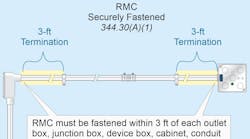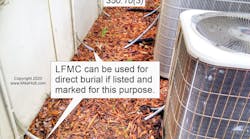Q. What are the Code requirements for a concrete-encased electrode?
A. A concrete-encased electrode must consist of at least 20 ft of either of the following [250.52(A)(3)], as shown in the Figure:
1) One or more of bare, zinc-galvanized, or otherwise electrically conductive steel reinforcing bars of not less than ½ in. diameter, mechanically connected together by steel tie wires, welding, or other effective means, to create a 20 ft or greater length.
2) Bare copper conductor not smaller than 4 AWG.
The reinforcing bars or bare copper conductor must be encased by at least 2 in. of concrete located horizontally near the bottom of a concrete footing or vertically within a concrete foundation that’s in direct contact with the earth.
If multiple concrete-encased electrodes are present at a building/structure, only one is required to serve as a grounding electrode.
Concrete containing insulation, vapor barriers, films, or similar items separating it from the earth isn't considered to be in "direct contact" with the earth.
The grounding electrode conductor to a concrete-encased grounding electrode isn't required to be larger than 4 AWG copper [250.66(B)].
The concrete-encased grounding electrode is also called a "Ufer Ground," named after a consultant working for the U.S. Army during World War II. The technique Mr. Ufer came up with was necessary because the site needing grounding had no underground water table and little rainfall. The desert site was a series of bomb storage vaults in the area of Flagstaff, Ariz. This type of grounding electrode generally offers the lowest ground resistance for the cost.





